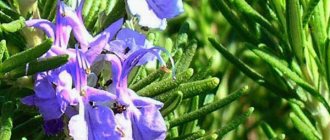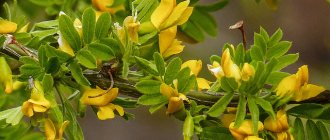Features and types of plants
This is a shrub with thin branches, most often not exceeding one meter in height and striking in its elegance. The bark is yellow with a bluish tint. Thin branches hang almost to the ground. The crown of the bush is dense and consists of opposite leaves ranging from 3 to 13 cm in length.
Linear-lanceolate stipules reach a length of up to 1.8 cm and fall off very early. During flowering, densely flowered, cylindrical catkins appear.
The plant tolerates both dry and wet periods well. It feels great after pruning and is widely used in landscape design.
There are not many species of this plant. The following varieties are popular.
Variety Nana
A low, spherical shrub reaching a height of up to 1.5 m and a width of up to two meters. The plant has a well-developed root system, which allows it to be used to strengthen the soil cover. Its shoots are thinner than those of the main species. They are brown with a red tint. The plant begins to flower in early spring, before or along with the leaves.
The shrub is characterized as frost-resistant and light-loving . It tolerates dry periods well and recovers quickly after pruning. Purple willow Nana is used in landscape design to strengthen and decorate the banks of various bodies of water. It can also often be found in bush groups in flooded areas. Nana is used in hedges and gardeners use it to create different shapes.
Iva Pendula
The shrub has a weeping crown shape with blue-green leaves. The plant tolerates prolonged flooding well, but is also considered drought-resistant. Willow tolerates the cold season well. It is used to decorate garden plots and strengthen the shoreline of reservoirs. This plant is propagated by grafting onto a standard.
Both types are distinguished by their unpretentiousness. However, it should be borne in mind that when planted on the shady side, the crown of these plants may change its shape and, as a result, lose its attractiveness.
Compatibility with other plants and interior items
Willow has its own character. A light purple tint combined with bright, lush greenery provides a certain contrast in the landscape. Therefore, willow nana is best combined with flowers, lawn and coniferous trees. The only thing is that gardeners do not recommend planting willow and any other trees, as well as shrubs next to walnut and birch. These are quite powerful varieties. They have a bad impact on any green neighbors.
Willow and interior
Recently, willow can be found quite often in home interiors. Its branches not only decorate the room, but are also depicted in paintings and objects. Nana willow branches tend to be stored for a long time when dried. The most suitable period for collecting branches is when a tree or bush is flowering. This way they will look better. When dried, they can last for a year. Home interior designers can also further decorate the branches by covering them with silver or gold paint. This way you can create a New Year and Christmas mood.
Due to its plasticity, willow can be woven into unusual decorative elements. The branches go well with ribbons and clear glass.
Propagation by cuttings
The main method of growing willow, besides pendula, is propagation by cuttings. You can also grow shrubs from seeds. But the fact is that their viability lasts only one week and their germination rate is very low. Cuttings are usually harvested in the spring, before the leaves appear, when the plant does not yet secrete a large amount of sap. For this process, specimens older than two years are selected .
Blanks 15-20 cm long are cut from the branches with a sharp knife. There must be from 5 to 7 buds on them. The top cut should be straight, and the bottom cut should be at 45°. Next, you need to germinate the cuttings, which can be done at home or in a greenhouse. Germination is carried out in several ways. The simplest is to place the blanks in a jar of water until the roots appear.
Some gardeners plant the cuttings in a box with wet sand, so that no more than two buds remain on the surface. This method is also used for autumn cuttings. In this case, the sand should be constantly watered so that it is wet all the time. Many gardeners recommend not to rush to plant seedlings in open ground.
First, the root system of the young plant needs to become stronger. To do this, prepare separate containers for each cutting and fill them with special soil for seedlings. The fact is that this soil contains all the necessary components for the development of a young plant. The seedlings end up completely ready for planting in open ground.
Reproduction
Willow nana is propagated vegetatively - by cuttings. To do this, in the spring, before the leaves appear, annual lignified branches up to 15 cm long are cut off. The cuttings are placed in a container with water, or buried in the ground to a depth of 5-7 cm, so that there are 2-3 buds above the ground. Cuts are made on the bottom of the cuttings from which roots will grow.
Willow takes root well, so cuttings can simply be stuck into the ground in a greenhouse or greenhouse, and after rooting, planted in a permanent place. To prevent the cuttings from drying out, they are watered regularly; it is not necessary to treat them with rooting agents or cover them with jars; the plant already takes root well.
For propagation, you can also use new, green cuttings; they are cut at an angle, the upper buds and leaves are removed, and the remaining leaves are shortened.
Sometimes cuttings for propagation are prepared in the fall, after the leaves have fallen. The shoots are packaged in polyethylene, the lower parts sprinkled with sand, and stored in the basement until spring.
Nurseries sell nana willow seedlings in containers, aged 1-2 years; when propagated at home, cuttings can be planted in open ground in the summer after rooting, or closer to autumn, along with a lump of earth. Young plants are completely covered for the winter - the above-ground part with covering material, and the roots with dry leaves or straw.
Planting seedlings in open ground
Purple willow can be planted almost throughout the season, but is best done in the spring. First, choose a location on the site. It must be light, and partial shade is also suitable. These plants do not grow in the shade, even in the wild. Having chosen a place for planting, they begin to prepare the soil cover.
If the plants will be used as single plantings, then the soil does not need to be dug up, but for a hedge, a strip of at least one meter wide should be dug up. Next, holes are prepared for each plant with a diameter of 0.5 m and a depth of 0.4 m. If the seedling is planted with seedling soil, then the size of the hole should correspond to the earthen coma.
A drainage layer of broken bricks or stones is laid at the bottom of the pit. A mixture of sand, peat and compost is poured on top, and fertilizer containing nitrogen is also applied. Carefully place the seedling in the hole and add the remaining soil. The soil around the seedling is compacted to form a pit for irrigation. 20 liters of warm water are poured under the young plant.
Types and varieties
In nature, there are more than 150 varieties of purple willow. The recognizable and unusual appearance attracted the attention of breeders, who worked hard and bred more than one variety with a decorative crown. As a result, shrubs are widely used for landscaping streets and courtyards.
Nana
A neat bush, no more than one and a half meters tall, with a dense spherical top of the same size. The branches are thin and flexible, reddish in color. The leaves are elongated, silver-green in color. The root system is spreading, so coastal areas of reservoirs are strengthened with willow. It tolerates frost and winter well; no shelter is required.
Pendula
The plant has an elegant original crown of a cascading shape, with branches descending to the ground. The variety is distinguished by thin and flexible shoots of a purple hue. It grows up to 1.5 meters and has light green or light green leaves. The shrub is equally resistant to frost and drought.
Weeping
The main difference is the large size. The height can reach up to 3 m, and the width of the crown can be 4-5 m. The dense foliage is painted in a bright green bluish color. The shoots fall to the very bottom, so the tree looks sad, which is why it got its name. Requires a lot of free space.
Gracilis
The low-growing spherical bush does not grow above one meter. It has graceful twigs and small leaves of a light emerald hue. The bush resembles an elegant cloud. Due to its neatness, it is used in decorating local areas.
Lighthouse
Willow with erect long branches that point upward. Developed by Ural scientists for weaving household products (baskets, cradles, chests, tables, chairs). It looks very unusual in street decoration.
Purple willow care
Willows grow quite quickly; some species can grow up to three meters annually. Therefore, they require proper care throughout the season. The most active care should be taken during the first time after planting. The following activities must be carried out:
- watering;
- feeding;
- pruning;
- preparation for winter.
This plant, especially young ones, must be watered regularly at least once a week, pouring 20 to 50 liters of water under each bush. Watering is carried out before sunrise or sunset. At the same time, not only the root system is watered, but also the crown of the bush. After this, you need to loosen the soil around each planting. During the season, the plant is fed two or three times. For this, complex mineral fertilizers are used.
At the end of summer, plants are fed with superphosphate and potassium sulfate. Willow pruning begins in the second or third year. The formation of bushes is carried out in the spring and after flowering. Don’t be afraid to cut branches; willow tolerates pruning well and recovers quite quickly. Purple willow is frost-resistant, but young plantings must be covered for the winter.
Features of purple willow
The plant belongs to the Willow family and is an elegant shrub that, depending on the species, can reach a height of 2 to 4 meters. The low-growing tree is widespread in the southern regions of Russia, Central Asia, China, Western Siberia, Mongolia, North Africa, and Western Europe. Its favorite places to grow are the banks of lakes and rivers or valleys rich in moist soil.
Description and varieties
Purple willow Nana has many thin, red-brown shoots that become gray-green over time. The inside of the branches is colored orange-lemon, which is why this plant is also called yellowvine. Light green foliage is characterized by a narrow and elongated shape with a size of 3.5 to 12 cm. With the onset of cold weather, the leaves acquire a golden color, characteristic of the autumn period.
Willow acquired its name because of its catkins, which appear on the tree in the spring, emitting a pleasant and sweetish aroma. They are large in size and red in color with a pearlescent tint, shimmering beautifully in the light. The shrub begins to bloom in late March or early April, at which time young leaves usually bloom on the branches.
The root system of the plant has a rather powerful structure that requires a lot of moisture, thanks to which the tree can grow very well on the banks of ponds, lakes or artificial reservoirs. Therefore, it is advisable to plant young bushes in fertile soils that have a composition completely suitable for Nana willow. Planting and care must be carried out according to certain rules, taking into account the needs of decorative plantings.
The tree is frost-resistant and can also tolerate drought well. But if the willow is provided with comfortable living conditions and all recommendations for cultivation are followed, then it will be able to delight with its beauty for 25-30 years.
In nature, there are more than 150 varieties of this plant. Today, breeding scientists have created various varieties that are distinguished by a more compact crown, thanks to which trees are widely used for decorating outdoor spaces. The following types of purple willow are especially popular:
- Nana. This bush has a miniature size and rather graceful shoots. Its height does not exceed 150 cm in height and 200 cm in width. The crown of the tree is semi-circular, the leaves are long, narrow, and colored green with a silvery tint. The flowering period is from mid-March to the end of April. The tree-like shrub grows well in sunny areas, withstands dry weather well, but feels best in places with moist soil.
- Рendula. It has a beautiful blue-green crown, with branches going down to the ground. The length of the bush is from 1 to 2 meters, width - 2.5 -3 meters. The foliage is small in size, the shoots are flexible, and colored in a dark red hue. In spring, the plant begins to bloom, at which time new leaves and catkins with reddish anthers appear on it.
- Glacillus. A very compact and neat bush, up to 1 meter high and a round crown, with a diameter of no more than 130 cm. The tree looks very cute, has small and delicate leaves, thin shoots and its appearance resembles a lush cloud with fuzzy edges. Due to its decorative properties, this type of willow is often used to decorate lawns, alpine slides and create hedges.
- Crying. This variety is distinguished by its larger size and very sophisticated appearance. Its height can reach 2-3 meters, width - 4-5 meters. The dense crown of the plant consists of bright green foliage with a bluish tint, the length of which reaches 9 cm. The branches of the tree smoothly flow down, which is why it looks drooping and is therefore called a weeping willow. The slender plant looks gorgeous on the banks of ponds, lakes and rivers with a calm flow.
All types of purple willow are distinguished by their special endurance, ability to tolerate any climatic conditions and the ability to grow in almost any soil. Therefore, tree-like bushes are an ideal decoration for summer cottages and are suitable for creating artistic compositions within the city.
Use in landscape design
Plants with a lush crown look great both in single and group plantings.
Purple willow Nana is used in landscape design to decorate gardens and rose gardens, as it goes well with various types of small trees and flowering plantings. It is also ideal for creating green hedges, decorating gazebos and borders in city parks. The dense and branched roots of willow are capable of strengthening the soil well, which is why such trees are often used for planting on the banks of artificial reservoirs. In addition, the spreading branches of the bush combine perfectly with the emerald surface of clear water.
The tree tolerates pruning very well, can thrive in fairly damp soil and is a suitable option for decorating areas with soil with high humidity.
Using secateurs from a spherical bush, artists create various figures that, with their unusual appearance, lift the spirits of adults and children.
Disease and pest control
The plant is very resistant to various diseases, but some of them can still affect the bush. These include:
- powdery mildew;
- rust;
- scab.
With powdery mildew, a white coating appears on the leaves of the plant. Bushes are treated using fungicides. When the weather is too wet, the leaves begin to turn black and then die completely. These are the first signs of scab disease. The affected areas of the plant are removed, and the bush is treated with a fungicide.
Rust is a fungal disease of leaves . It can be identified by the appearance of red spots. The affected parts of the plant are removed and must be burned. Among the pests, it is worth noting the willow moth, leaf beetle and silkworm. Caterpillars of the moth butterfly eat the leaves of a bush. To combat them, insecticides are sprayed.
The leaves are also eaten by leaf beetles. For the winter, these beetles burrow into the ground near plants. Therefore, it is recommended to burn straw and old leaves in these places. Silkworm butterflies lay eggs on the leaves of bushes. The emerging caterpillars destroy all green growth. To combat them, it is recommended to attract sparrows and bats or collect the pest manually. With good care, willow grows into a very beautiful, decorative bush, which can be used as a hedge or to strengthen the banks of a reservoir. It will decorate any area.
Growing the Nana variety
Hybrid planting material is prepared in specialized nurseries. You can propagate Nana willow by cuttings and plant them directly in the ground in a permanent place. To ensure good engraftment, seedlings with a closed root system are prepared.
Purple willow Nana is not capricious; it grows on various soils in conditions of moderate and high humidity and tolerates dry periods. Purple willow of the Nana variety is more demanding regarding the amount of light. Undesirable neighbors are tall trees that create shade. It is not recommended to plant birch trees and nuts next to willow. After selecting a well-lit area, seedlings with a developed root system are selected, marked and planted:
- The planting hole is dug at least 50x50 cm or in dimensions significantly larger than the size of the earthen ball in order to maintain its integrity during planting.
- In order for purple willow Nana to form a large spherical bush, it is necessary to ensure a distance between neighboring plants of at least 1 m.
- If the soil is waterlogged, drainage is placed at the bottom of the hole. You can use broken bricks, expanded clay, small stones or coarse gravel.
- The dry hole is watered generously.
- Humus, peat, and fertile soil are poured over the drainage.
- Well moisturize the earthen ball of the seedling. If purple willow Nana is planted with an open root system, the roots of the seedling are placed in water for several hours.
- The roots are sprinkled, the soil is compacted and watered abundantly.
The plant does not require care. If the shrub grows in humid conditions near a pond, it does not even require watering. In a garden or urban environment, plant care will require more, but these are simple, traditional techniques:
- Water as the soil dries generously from a bucket or hose. After planting, purple willow Nana requires more frequent watering compared to a well-rooted shrub.
- Loosening the soil and killing weeds. Deep loosening (up to 20 cm) can be carried out around young plantings, and superficial loosening around adults (up to 5 cm), since purple willow Nana has many roots close to the soil surface.
- Feeding is carried out twice a year. In the spring, use a complex fertilizer with a predominance of nitrogen. For autumn feeding, phosphorus-potassium fertilizers are more appropriate.
Trimming
The event is held for two reasons:
- Crown formation. A neat, attractive appearance or decorative forms of geometric objects, animals, and sculptural compositions are created. In spherical crowns, protruding shoots are cut off. Hedges are trimmed at the same level or in steps.
- Sanitary pruning. Dry, damaged, twisted shoots with signs of disease must be removed. Old, weakened shrubs are often pruned to the stump to encourage the growth of new, healthy branches.
Stump pruning is suitable for Nana willow. During the new season, it is able to produce new, spectacular and delicate shoots that are even more decorative.











